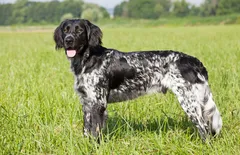
Cane Corso
Smart, trainable, and of noble bearing, the assertive and confident Cane Corso is a peerless protector.
Overall Status
| Height | 23.5 to 27.5 inches |
| Temperament | Affectionate, Intelligent, Majestic |
| Weight | Proportionate to height |
| Life Expectancy | 9 to 12 years |
| Coat Color | Black, Black Brindle, Chestnut Brindle, Fawn, Gray |
| Barking Level | Infrequent |
Quick Factors
| Playfulness | |
| Dog Friendly | |
| Exercise Need | |
| Grooming Needs | |
| Strangers Friendly | |
| Family Affectionate |
Daily Care
Grooming Tips
The Cane Corso’s coat is short but double-layered. The undercoat, which varies in length depending on the climate the dog lives in,shedsthroughout the year, especially during shedding season in the spring. Weeklybrushing—daily during shedding season—with a medium-bristle brush, a rubber grooming mitt or tool, or a hound glove will remove the dead hair before it can fall onto the furniture, and it helps remove dirt and promotes new hair growth as well.Check the ears on a weekly basis for signs of infection, irritation, or wax build up. Cleanse regularly with a veterinarian-approved cleanser and cotton ball. Brush the teeth at least once per week to prevent tartar buildup and fight gum disease. Additionally, nails should be trimmed once per month if the dog does not wear down the toenails naturally.
Exercise Tips
Cane Corsos need seriousexercise. A brisk walk—or better yet, run—of at least a mile in the morning and again in the evening will sustain their health and muscle tone. They make great companions on long walks, hikes, or bicycle rides. The Cane Corso was bred to work and is happiest when given a job to do. He needs mental as well as physical stimulation, or undesirable behavior will result. Many Cane Corsos compete inagility,obedience, dock diving, protection sport, andtrackingevents.With this said, Cane Corsos puppies should not be given too much exercise because their joints and bones are still growing and too much pressure on them could result in causing a dog a few problems later on in their lives. They should not be allowed to jump up or off furniture nor should they be allowed to run up and down the stairs because this puts too much pressure on their still growing joints and limbs.
Feeding Tips
If you get a Samoyed puppy from a breeder, they would give you a feeding schedule and it's important to stick to the same routine, feeding the same puppy food to avoid any tummy upsets. You can change a puppy's diet, but this needs to be done very gradually always making sure they don't develop any digestive upsets and if they do, it's best to put them back on their original diet and to discuss things with the vet before attempting to change it again.Older dogs are not known to be fussy or finicky eaters, but this does not mean you can feed them a lower quality diet. It's best to feed a mature dog twice a day, once in the morning and then again in the evening, making sure it's good quality food that meets all their nutritional requirements. It's also important that dogs be given the right amount of exercise so they burn off any excess calories or they might gain too much weight which can lead to all sorts of health issues. Obesity can shorten a dog's life by several years so it's important to keep an eye on their waistline from the word go.Learn about which human foods are safe for dogs, and which are not. Check with your vet if you have any concerns about your dog’s weight or diet. Clean, fresh water should be available at all times. Like many large breeds, Saint Bernard can experience bloat, a life-threatening condition where the stomach distends and twists. The causes of bloat aren’t fully understood, but experts agree that multiple, small meals per day and preventing vigorous exercise around mealtimes may help reduce the chances of it happening.
Health Tips
All dogs have the potential to develop genetic health problems, just as all people have the potential to inherit a particular disease. Run, don’t walk, from any breeder who does not offer a health guarantee on puppies, who tells you that the breed is 100 percent healthy and has no known problems, or who tells you that her puppies are isolated from the main part of the household for health reasons. A reputable breeder will be honest and open about health problems in the breed and the incidence with which they occur in her lines.Cane Corsos are generally healthy dogs, andresponsible breedersscreen their stock for health conditions such aship dysplasia, idiopathic epilepsy, demodex mange, and eyelid abnormalities.vLarge and deep-chested breeds are susceptible tobloat, a sudden, life-threatening stomach condition. Cane Corso owners should learn what signs to look out for, and what to do should they occur. As with all breeds, a Cane Corso’s ears should be checked regularly for signs ofinfection, and theteethshould be brushed often, using a toothpaste designed for dogs.
Trainability
Earlysocializationandpuppy training classesare recommended for all dogs, but for a breed as big and strong as a Cane Corso, they are a must. Many Cane Corsos can be dominant and protective; socialization will help ensure that they grow into well-adjusted, well-mannered adults.Obedience training will keep them from becoming the boss in the household. Cane Corsos are intelligent and eager to please, so they are generally easy to train. Despite their appearance, Cane Corsos are all heart and respond to love and rewards far better than to harsh corrections or training methods.Puppies should be properly socialized to develop the amiable, outgoing personality that is characteristic of the breed. They’re successful in performance and companion events such as earthdog, barn hunt, obedience, and agility.
History
The Cane Corso Italiano (also known as the ‘Italian Mastiff’ or ‘Cane Corso Mastiff’) is a war and hunting dog which originated in southern Italy. It likely descends from the Neapolitan mastiff and the Roman ‘Canis Pugnax’, a powerful war dog, though the Cane Corso Italiano is a lighter, more agile breed which was used by troops for hunting or as an auxiliary force (‘Corso’ comes from the Latin for ‘guardian’). The Cane Corso Italiano was also used in bull baiting, a gambling ‘sport’ wherein one or more dogs were matched up against a chained bull.Specimens did survive, however, in Italy’s backcountry. In the 1970s, a group of Italian fanciers banded together to revive the breed of their rustic ancestors. The Society Amorati Cane Corso (Society of Cane Corso Lovers) was formed in 1983, and by the following decade, Corsi was being exhibited in European dog shows. The first Corso import arrived in America in 1988, and in 2010 the breed was recognized by the AKC.






